Trauma and Sexual Abuse - Understanding the Difference between Single-Incident Trauma and Complex Trauma
VerifiedAdded on 2022/11/23
|6
|1580
|276
AI Summary
This essay discusses the difference between single-incident trauma and complex trauma related to sexual abuse. It highlights the symptoms of PTSD and the diagnostic criteria for children under six years of age. The essay also explains the concept of psychological trauma and its impact on an individual's mental health.
Contribute Materials
Your contribution can guide someone’s learning journey. Share your
documents today.
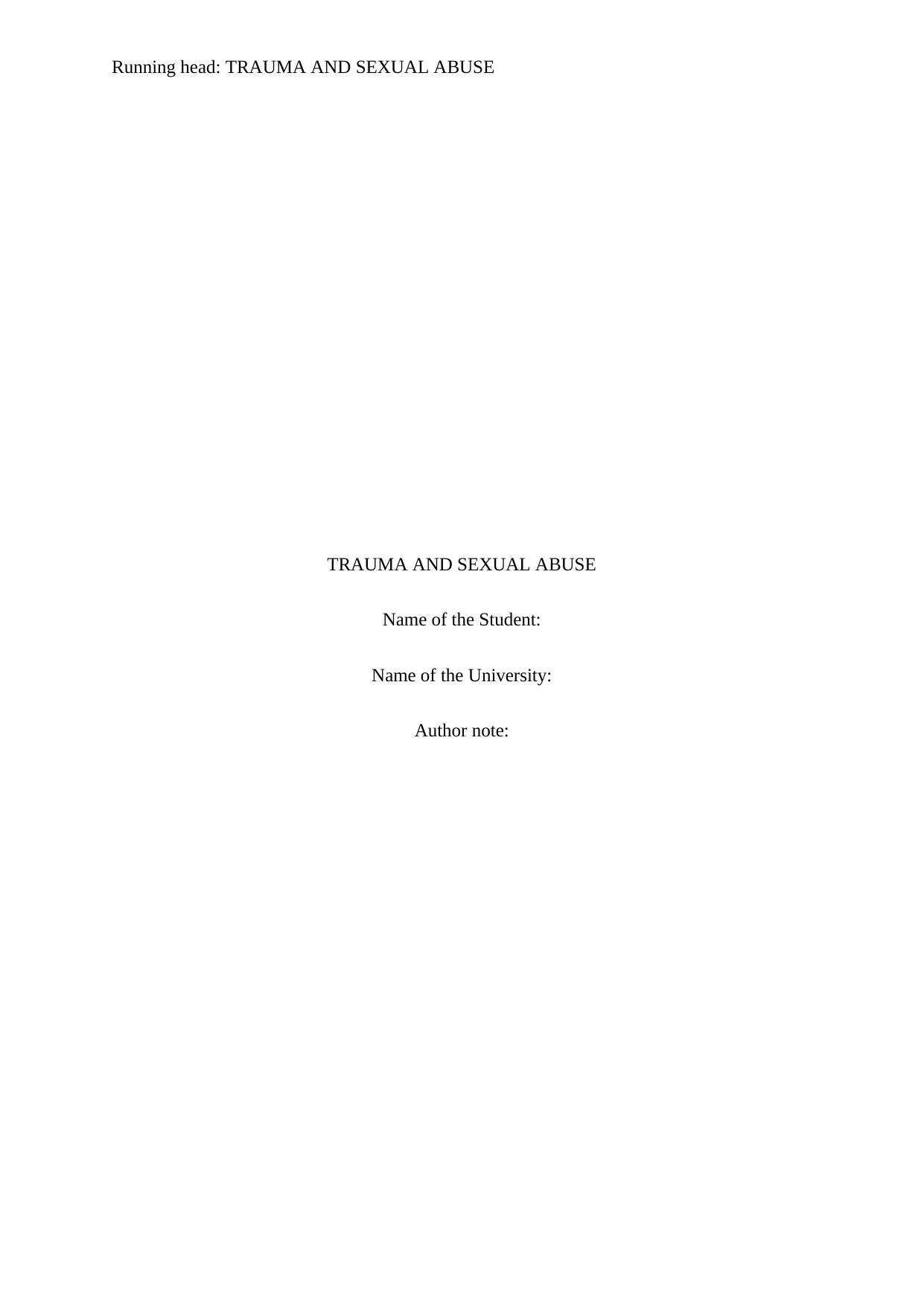
Running head: TRAUMA AND SEXUAL ABUSE
TRAUMA AND SEXUAL ABUSE
Name of the Student:
Name of the University:
Author note:
TRAUMA AND SEXUAL ABUSE
Name of the Student:
Name of the University:
Author note:
Secure Best Marks with AI Grader
Need help grading? Try our AI Grader for instant feedback on your assignments.
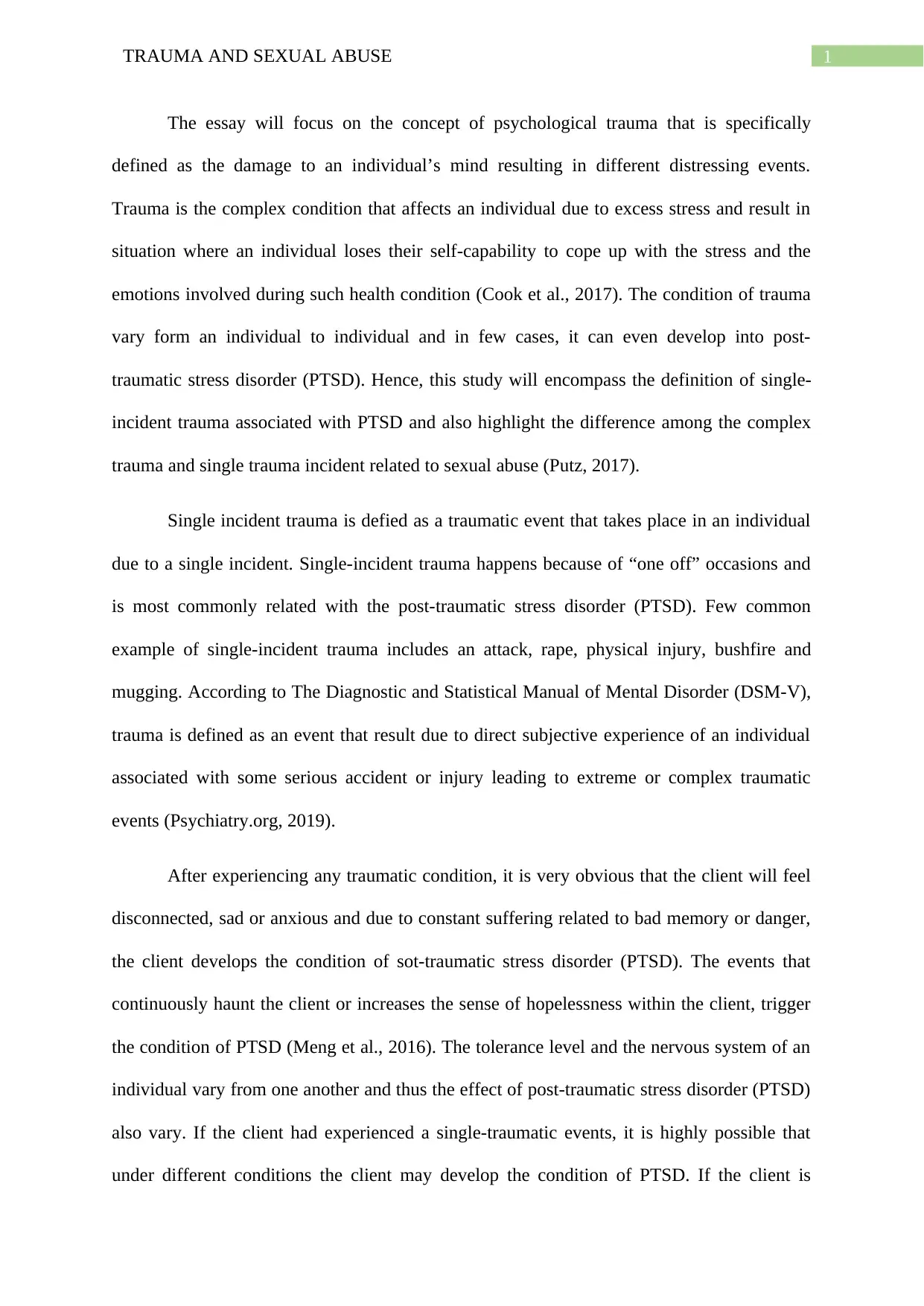
1TRAUMA AND SEXUAL ABUSE
The essay will focus on the concept of psychological trauma that is specifically
defined as the damage to an individual’s mind resulting in different distressing events.
Trauma is the complex condition that affects an individual due to excess stress and result in
situation where an individual loses their self-capability to cope up with the stress and the
emotions involved during such health condition (Cook et al., 2017). The condition of trauma
vary form an individual to individual and in few cases, it can even develop into post-
traumatic stress disorder (PTSD). Hence, this study will encompass the definition of single-
incident trauma associated with PTSD and also highlight the difference among the complex
trauma and single trauma incident related to sexual abuse (Putz, 2017).
Single incident trauma is defied as a traumatic event that takes place in an individual
due to a single incident. Single-incident trauma happens because of “one off” occasions and
is most commonly related with the post-traumatic stress disorder (PTSD). Few common
example of single-incident trauma includes an attack, rape, physical injury, bushfire and
mugging. According to The Diagnostic and Statistical Manual of Mental Disorder (DSM-V),
trauma is defined as an event that result due to direct subjective experience of an individual
associated with some serious accident or injury leading to extreme or complex traumatic
events (Psychiatry.org, 2019).
After experiencing any traumatic condition, it is very obvious that the client will feel
disconnected, sad or anxious and due to constant suffering related to bad memory or danger,
the client develops the condition of sot-traumatic stress disorder (PTSD). The events that
continuously haunt the client or increases the sense of hopelessness within the client, trigger
the condition of PTSD (Meng et al., 2016). The tolerance level and the nervous system of an
individual vary from one another and thus the effect of post-traumatic stress disorder (PTSD)
also vary. If the client had experienced a single-traumatic events, it is highly possible that
under different conditions the client may develop the condition of PTSD. If the client is
The essay will focus on the concept of psychological trauma that is specifically
defined as the damage to an individual’s mind resulting in different distressing events.
Trauma is the complex condition that affects an individual due to excess stress and result in
situation where an individual loses their self-capability to cope up with the stress and the
emotions involved during such health condition (Cook et al., 2017). The condition of trauma
vary form an individual to individual and in few cases, it can even develop into post-
traumatic stress disorder (PTSD). Hence, this study will encompass the definition of single-
incident trauma associated with PTSD and also highlight the difference among the complex
trauma and single trauma incident related to sexual abuse (Putz, 2017).
Single incident trauma is defied as a traumatic event that takes place in an individual
due to a single incident. Single-incident trauma happens because of “one off” occasions and
is most commonly related with the post-traumatic stress disorder (PTSD). Few common
example of single-incident trauma includes an attack, rape, physical injury, bushfire and
mugging. According to The Diagnostic and Statistical Manual of Mental Disorder (DSM-V),
trauma is defined as an event that result due to direct subjective experience of an individual
associated with some serious accident or injury leading to extreme or complex traumatic
events (Psychiatry.org, 2019).
After experiencing any traumatic condition, it is very obvious that the client will feel
disconnected, sad or anxious and due to constant suffering related to bad memory or danger,
the client develops the condition of sot-traumatic stress disorder (PTSD). The events that
continuously haunt the client or increases the sense of hopelessness within the client, trigger
the condition of PTSD (Meng et al., 2016). The tolerance level and the nervous system of an
individual vary from one another and thus the effect of post-traumatic stress disorder (PTSD)
also vary. If the client had experienced a single-traumatic events, it is highly possible that
under different conditions the client may develop the condition of PTSD. If the client is
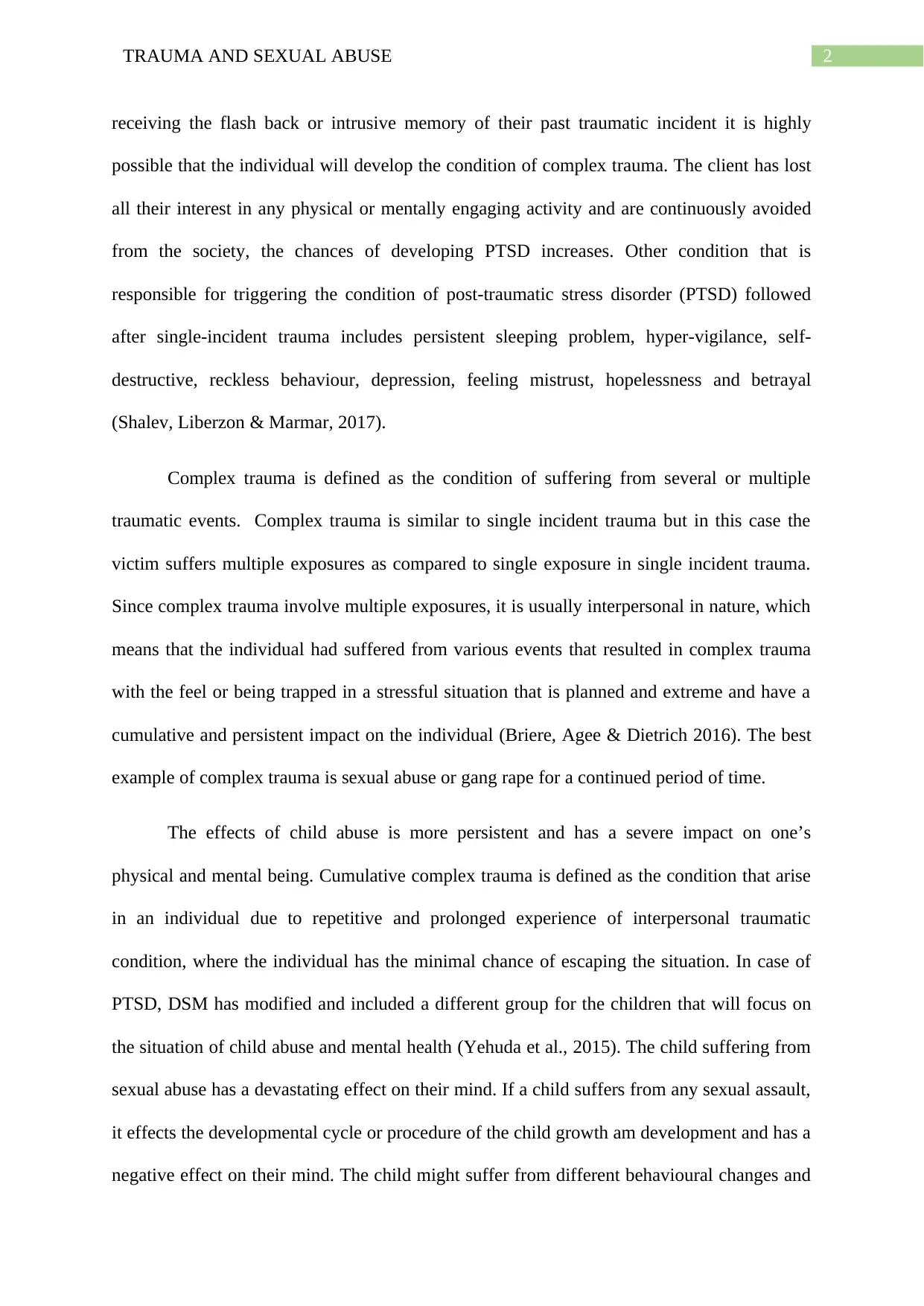
2TRAUMA AND SEXUAL ABUSE
receiving the flash back or intrusive memory of their past traumatic incident it is highly
possible that the individual will develop the condition of complex trauma. The client has lost
all their interest in any physical or mentally engaging activity and are continuously avoided
from the society, the chances of developing PTSD increases. Other condition that is
responsible for triggering the condition of post-traumatic stress disorder (PTSD) followed
after single-incident trauma includes persistent sleeping problem, hyper-vigilance, self-
destructive, reckless behaviour, depression, feeling mistrust, hopelessness and betrayal
(Shalev, Liberzon & Marmar, 2017).
Complex trauma is defined as the condition of suffering from several or multiple
traumatic events. Complex trauma is similar to single incident trauma but in this case the
victim suffers multiple exposures as compared to single exposure in single incident trauma.
Since complex trauma involve multiple exposures, it is usually interpersonal in nature, which
means that the individual had suffered from various events that resulted in complex trauma
with the feel or being trapped in a stressful situation that is planned and extreme and have a
cumulative and persistent impact on the individual (Briere, Agee & Dietrich 2016). The best
example of complex trauma is sexual abuse or gang rape for a continued period of time.
The effects of child abuse is more persistent and has a severe impact on one’s
physical and mental being. Cumulative complex trauma is defined as the condition that arise
in an individual due to repetitive and prolonged experience of interpersonal traumatic
condition, where the individual has the minimal chance of escaping the situation. In case of
PTSD, DSM has modified and included a different group for the children that will focus on
the situation of child abuse and mental health (Yehuda et al., 2015). The child suffering from
sexual abuse has a devastating effect on their mind. If a child suffers from any sexual assault,
it effects the developmental cycle or procedure of the child growth am development and has a
negative effect on their mind. The child might suffer from different behavioural changes and
receiving the flash back or intrusive memory of their past traumatic incident it is highly
possible that the individual will develop the condition of complex trauma. The client has lost
all their interest in any physical or mentally engaging activity and are continuously avoided
from the society, the chances of developing PTSD increases. Other condition that is
responsible for triggering the condition of post-traumatic stress disorder (PTSD) followed
after single-incident trauma includes persistent sleeping problem, hyper-vigilance, self-
destructive, reckless behaviour, depression, feeling mistrust, hopelessness and betrayal
(Shalev, Liberzon & Marmar, 2017).
Complex trauma is defined as the condition of suffering from several or multiple
traumatic events. Complex trauma is similar to single incident trauma but in this case the
victim suffers multiple exposures as compared to single exposure in single incident trauma.
Since complex trauma involve multiple exposures, it is usually interpersonal in nature, which
means that the individual had suffered from various events that resulted in complex trauma
with the feel or being trapped in a stressful situation that is planned and extreme and have a
cumulative and persistent impact on the individual (Briere, Agee & Dietrich 2016). The best
example of complex trauma is sexual abuse or gang rape for a continued period of time.
The effects of child abuse is more persistent and has a severe impact on one’s
physical and mental being. Cumulative complex trauma is defined as the condition that arise
in an individual due to repetitive and prolonged experience of interpersonal traumatic
condition, where the individual has the minimal chance of escaping the situation. In case of
PTSD, DSM has modified and included a different group for the children that will focus on
the situation of child abuse and mental health (Yehuda et al., 2015). The child suffering from
sexual abuse has a devastating effect on their mind. If a child suffers from any sexual assault,
it effects the developmental cycle or procedure of the child growth am development and has a
negative effect on their mind. The child might suffer from different behavioural changes and
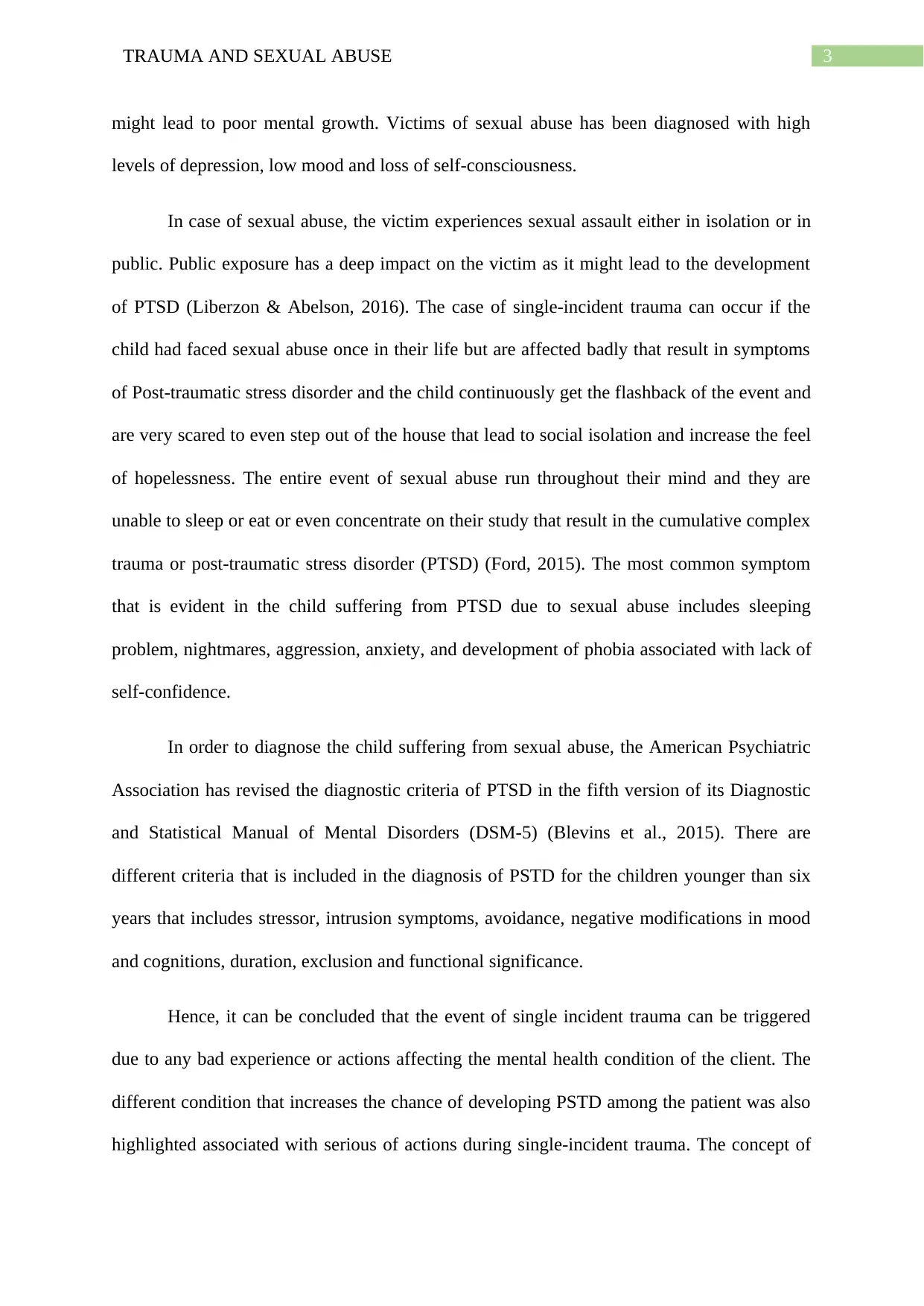
3TRAUMA AND SEXUAL ABUSE
might lead to poor mental growth. Victims of sexual abuse has been diagnosed with high
levels of depression, low mood and loss of self-consciousness.
In case of sexual abuse, the victim experiences sexual assault either in isolation or in
public. Public exposure has a deep impact on the victim as it might lead to the development
of PTSD (Liberzon & Abelson, 2016). The case of single-incident trauma can occur if the
child had faced sexual abuse once in their life but are affected badly that result in symptoms
of Post-traumatic stress disorder and the child continuously get the flashback of the event and
are very scared to even step out of the house that lead to social isolation and increase the feel
of hopelessness. The entire event of sexual abuse run throughout their mind and they are
unable to sleep or eat or even concentrate on their study that result in the cumulative complex
trauma or post-traumatic stress disorder (PTSD) (Ford, 2015). The most common symptom
that is evident in the child suffering from PTSD due to sexual abuse includes sleeping
problem, nightmares, aggression, anxiety, and development of phobia associated with lack of
self-confidence.
In order to diagnose the child suffering from sexual abuse, the American Psychiatric
Association has revised the diagnostic criteria of PTSD in the fifth version of its Diagnostic
and Statistical Manual of Mental Disorders (DSM-5) (Blevins et al., 2015). There are
different criteria that is included in the diagnosis of PSTD for the children younger than six
years that includes stressor, intrusion symptoms, avoidance, negative modifications in mood
and cognitions, duration, exclusion and functional significance.
Hence, it can be concluded that the event of single incident trauma can be triggered
due to any bad experience or actions affecting the mental health condition of the client. The
different condition that increases the chance of developing PSTD among the patient was also
highlighted associated with serious of actions during single-incident trauma. The concept of
might lead to poor mental growth. Victims of sexual abuse has been diagnosed with high
levels of depression, low mood and loss of self-consciousness.
In case of sexual abuse, the victim experiences sexual assault either in isolation or in
public. Public exposure has a deep impact on the victim as it might lead to the development
of PTSD (Liberzon & Abelson, 2016). The case of single-incident trauma can occur if the
child had faced sexual abuse once in their life but are affected badly that result in symptoms
of Post-traumatic stress disorder and the child continuously get the flashback of the event and
are very scared to even step out of the house that lead to social isolation and increase the feel
of hopelessness. The entire event of sexual abuse run throughout their mind and they are
unable to sleep or eat or even concentrate on their study that result in the cumulative complex
trauma or post-traumatic stress disorder (PTSD) (Ford, 2015). The most common symptom
that is evident in the child suffering from PTSD due to sexual abuse includes sleeping
problem, nightmares, aggression, anxiety, and development of phobia associated with lack of
self-confidence.
In order to diagnose the child suffering from sexual abuse, the American Psychiatric
Association has revised the diagnostic criteria of PTSD in the fifth version of its Diagnostic
and Statistical Manual of Mental Disorders (DSM-5) (Blevins et al., 2015). There are
different criteria that is included in the diagnosis of PSTD for the children younger than six
years that includes stressor, intrusion symptoms, avoidance, negative modifications in mood
and cognitions, duration, exclusion and functional significance.
Hence, it can be concluded that the event of single incident trauma can be triggered
due to any bad experience or actions affecting the mental health condition of the client. The
different condition that increases the chance of developing PSTD among the patient was also
highlighted associated with serious of actions during single-incident trauma. The concept of
Secure Best Marks with AI Grader
Need help grading? Try our AI Grader for instant feedback on your assignments.
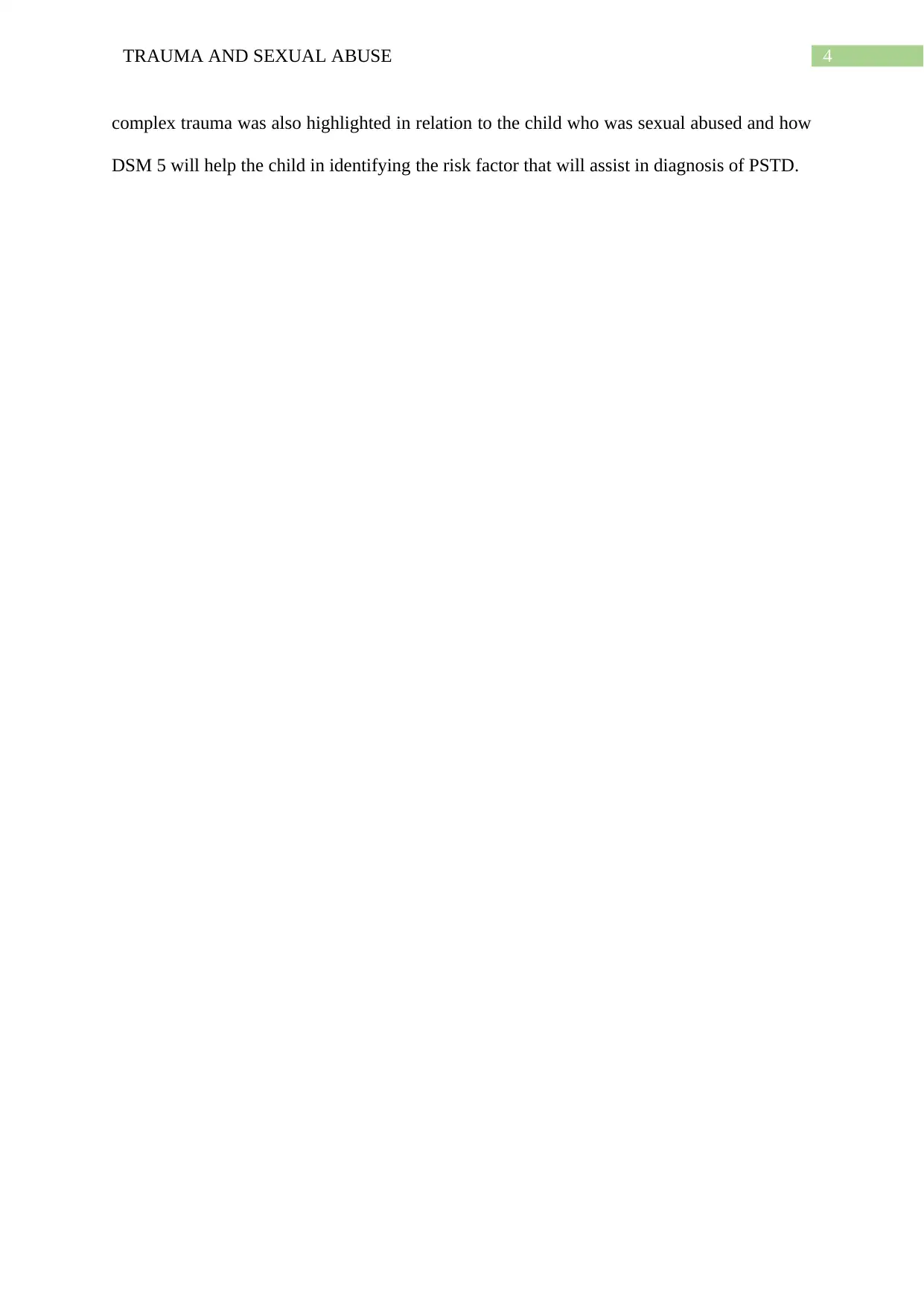
4TRAUMA AND SEXUAL ABUSE
complex trauma was also highlighted in relation to the child who was sexual abused and how
DSM 5 will help the child in identifying the risk factor that will assist in diagnosis of PSTD.
complex trauma was also highlighted in relation to the child who was sexual abused and how
DSM 5 will help the child in identifying the risk factor that will assist in diagnosis of PSTD.
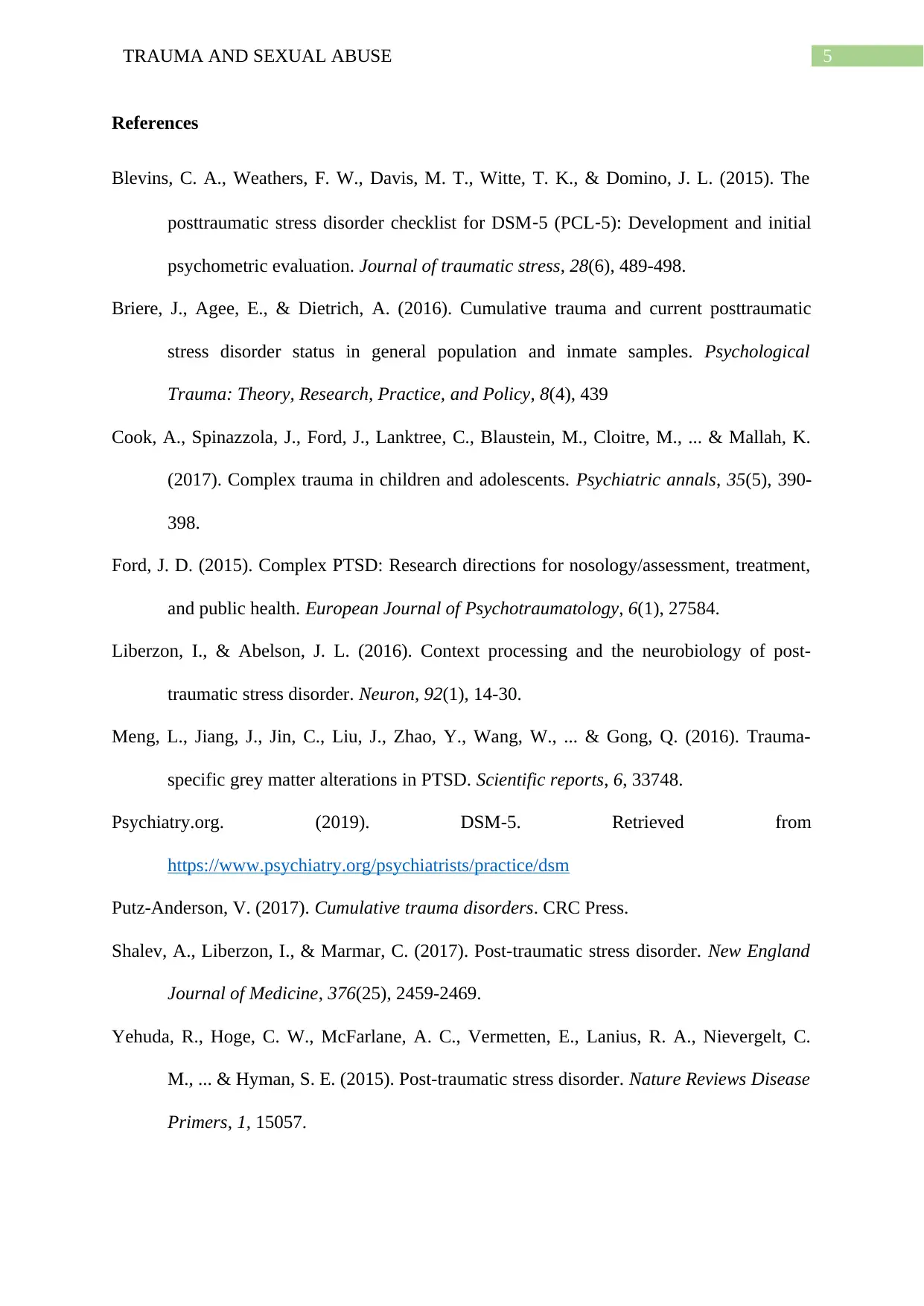
5TRAUMA AND SEXUAL ABUSE
References
Blevins, C. A., Weathers, F. W., Davis, M. T., Witte, T. K., & Domino, J. L. (2015). The
posttraumatic stress disorder checklist for DSM‐5 (PCL‐5): Development and initial
psychometric evaluation. Journal of traumatic stress, 28(6), 489-498.
Briere, J., Agee, E., & Dietrich, A. (2016). Cumulative trauma and current posttraumatic
stress disorder status in general population and inmate samples. Psychological
Trauma: Theory, Research, Practice, and Policy, 8(4), 439
Cook, A., Spinazzola, J., Ford, J., Lanktree, C., Blaustein, M., Cloitre, M., ... & Mallah, K.
(2017). Complex trauma in children and adolescents. Psychiatric annals, 35(5), 390-
398.
Ford, J. D. (2015). Complex PTSD: Research directions for nosology/assessment, treatment,
and public health. European Journal of Psychotraumatology, 6(1), 27584.
Liberzon, I., & Abelson, J. L. (2016). Context processing and the neurobiology of post-
traumatic stress disorder. Neuron, 92(1), 14-30.
Meng, L., Jiang, J., Jin, C., Liu, J., Zhao, Y., Wang, W., ... & Gong, Q. (2016). Trauma-
specific grey matter alterations in PTSD. Scientific reports, 6, 33748.
Psychiatry.org. (2019). DSM-5. Retrieved from
https://www.psychiatry.org/psychiatrists/practice/dsm
Putz-Anderson, V. (2017). Cumulative trauma disorders. CRC Press.
Shalev, A., Liberzon, I., & Marmar, C. (2017). Post-traumatic stress disorder. New England
Journal of Medicine, 376(25), 2459-2469.
Yehuda, R., Hoge, C. W., McFarlane, A. C., Vermetten, E., Lanius, R. A., Nievergelt, C.
M., ... & Hyman, S. E. (2015). Post-traumatic stress disorder. Nature Reviews Disease
Primers, 1, 15057.
References
Blevins, C. A., Weathers, F. W., Davis, M. T., Witte, T. K., & Domino, J. L. (2015). The
posttraumatic stress disorder checklist for DSM‐5 (PCL‐5): Development and initial
psychometric evaluation. Journal of traumatic stress, 28(6), 489-498.
Briere, J., Agee, E., & Dietrich, A. (2016). Cumulative trauma and current posttraumatic
stress disorder status in general population and inmate samples. Psychological
Trauma: Theory, Research, Practice, and Policy, 8(4), 439
Cook, A., Spinazzola, J., Ford, J., Lanktree, C., Blaustein, M., Cloitre, M., ... & Mallah, K.
(2017). Complex trauma in children and adolescents. Psychiatric annals, 35(5), 390-
398.
Ford, J. D. (2015). Complex PTSD: Research directions for nosology/assessment, treatment,
and public health. European Journal of Psychotraumatology, 6(1), 27584.
Liberzon, I., & Abelson, J. L. (2016). Context processing and the neurobiology of post-
traumatic stress disorder. Neuron, 92(1), 14-30.
Meng, L., Jiang, J., Jin, C., Liu, J., Zhao, Y., Wang, W., ... & Gong, Q. (2016). Trauma-
specific grey matter alterations in PTSD. Scientific reports, 6, 33748.
Psychiatry.org. (2019). DSM-5. Retrieved from
https://www.psychiatry.org/psychiatrists/practice/dsm
Putz-Anderson, V. (2017). Cumulative trauma disorders. CRC Press.
Shalev, A., Liberzon, I., & Marmar, C. (2017). Post-traumatic stress disorder. New England
Journal of Medicine, 376(25), 2459-2469.
Yehuda, R., Hoge, C. W., McFarlane, A. C., Vermetten, E., Lanius, R. A., Nievergelt, C.
M., ... & Hyman, S. E. (2015). Post-traumatic stress disorder. Nature Reviews Disease
Primers, 1, 15057.
1 out of 6
Related Documents
Your All-in-One AI-Powered Toolkit for Academic Success.
+13062052269
info@desklib.com
Available 24*7 on WhatsApp / Email
![[object Object]](/_next/static/media/star-bottom.7253800d.svg)
Unlock your academic potential
© 2024 | Zucol Services PVT LTD | All rights reserved.




